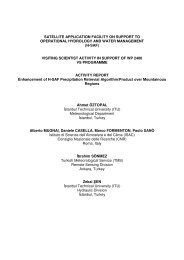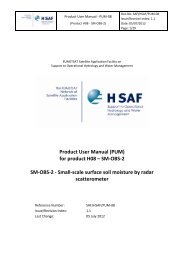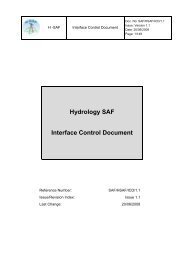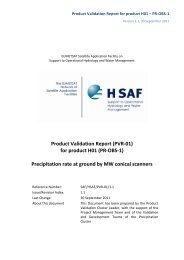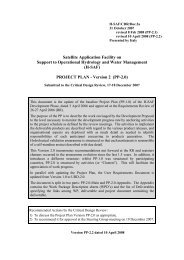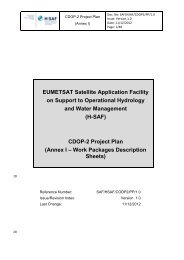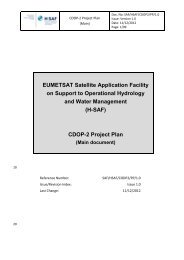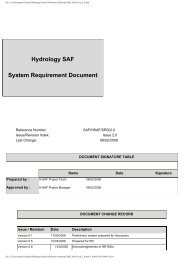H-SAF Product Validation Report (PVR) PR-OBS-3
H-SAF Product Validation Report (PVR) PR-OBS-3
H-SAF Product Validation Report (PVR) PR-OBS-3
Create successful ePaper yourself
Turn your PDF publications into a flip-book with our unique Google optimized e-Paper software.
<strong>Product</strong>s <strong>Validation</strong> <strong>Report</strong>, 30 May 2010 - <strong>PVR</strong>-03 (<strong>Product</strong> <strong>PR</strong>-<strong>OBS</strong>-3) Page 10<br />
The blending technique adopted for <strong>PR</strong>-<strong>OBS</strong>-3 is called “Rapid Update (RU)”; see, for instance, Turk et<br />
al. 2000 1 .<br />
Key to the RU blended satellite technique is a real time, underlying collection of time and spaceintersecting<br />
pixels from operational geostationary IR imagers and LEO MW sensors. Rain intensity<br />
maps derived from MW measurements are used to create global, geo-located rain rate (RR) and T B<br />
(brightness temperature) relationships that are renewed as soon as new co-located data are available<br />
from both geostationary and MW instruments. In the software package these relationships are called<br />
histograms. To the end of geo-locating histogram relationships, the globe (or the study area) is<br />
subdivided in equally spaced lat-lon boxes (2.5°×2.5°). As new input datasets (MW and IR) are<br />
available in the processing chain, the MW-derived rain rate pixels are paired with their time and spacecoincident<br />
geostationary 10.8-µm IR equivalent blackbody temperature (T BB ) data, using a 15-minute<br />
maximum allowed time offset between the pixel observation times.<br />
2.3 Main operational characteristics<br />
The operational characteristics of <strong>PR</strong>-<strong>OBS</strong>-3 are discussed in PUM-03. Here are the main highlights.<br />
The horizontal resolution ( x) is the convolution of several features (sampling distance, degree of<br />
independence of the information relative to nearby samples, …). The horizontal resolution descends<br />
from the instrument Instantaneous Field of View (IFOV), the sampling distance (pixel), the Modulation<br />
Transfer Function (MTF) and number of pixels to co-process for filtering out disturbing factors (e.g.<br />
clouds) or improving accuracy. The IFOV of SEVIRI images is 4.8 km at nadir, and degrades moving<br />
away from nadir, becoming about 8 km in the H-<strong>SAF</strong> area. A figure representative of the <strong>PR</strong>-<strong>OBS</strong>-3<br />
resolution is: ~ 8 km. Sampling is made at ~ 5 km intervals, consistent with the SEVIRI pixel over<br />
Europe. Conclusion:<br />
resolution x ~ 8 km - sampling distance: ~ 5 km.<br />
The observing cycle ( t) is defined as the average time interval between two measurements over the<br />
same area. In the case of <strong>PR</strong>-<strong>OBS</strong>-3 the product is generated soon after each SEVIRI new acquisition,<br />
Thus:<br />
observing cycle t = 15 min - sampling time: 15 min.<br />
The timeliness ( ) is defined as the time between observation taking and product available at the user<br />
site assuming a defined dissemination mean. The timeliness depends on the satellite transmission<br />
facilities, the availability of acquisition stations, the processing time required to generate the product<br />
and the reference dissemination means. For <strong>PR</strong>-<strong>OBS</strong>-3, the time of observations is 1-5 min before each<br />
quarter of an hour, ending at the full hour. To this, ~ 5 min have to be added for acquisition through<br />
EUMETCast and ~ 5 min for processing at CNMCA, thus:<br />
timeliness ~ 15 min.<br />
The accuracy (RMS) is the convolution of several measurement features (random error, bias, sensitivity,<br />
precision, …). To simplify matters, it is generally agreed to quote the root-mean-square difference<br />
[observed - true values]. The accuracy of a satellite-derived product descends from the strength of the<br />
physical principle linking the satellite observation to the natural process determining the parameter. It is<br />
difficult to be estimated a-priori: it is generally evaluated a-posteriori by means of the validation<br />
activity.<br />
1 Turk J.F., G. Rohaly, J. Hawkins, E.A. Smith, F.S. Marzano, A. Mugnai and V. Levizzani, 2000: “Analysis and<br />
assimilation of rainfall from blended SSMI, TRMM and geostationary satellite data”. Proc. 10th AMS Conf. Sat.<br />
Meteor. and Ocean., 9, 66-69.




